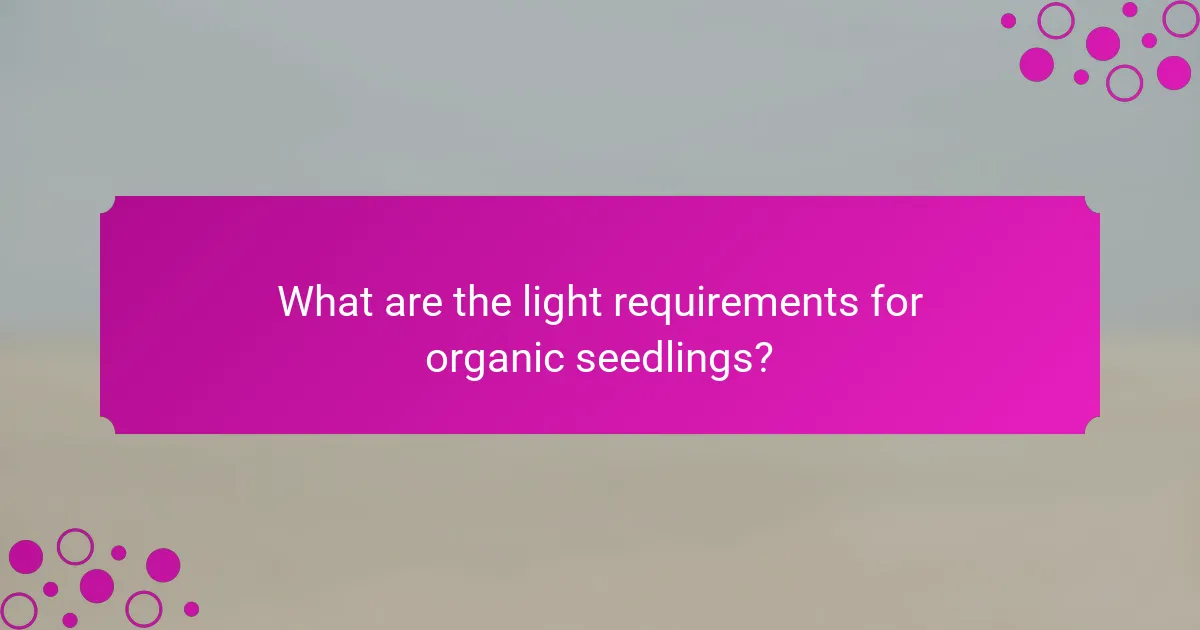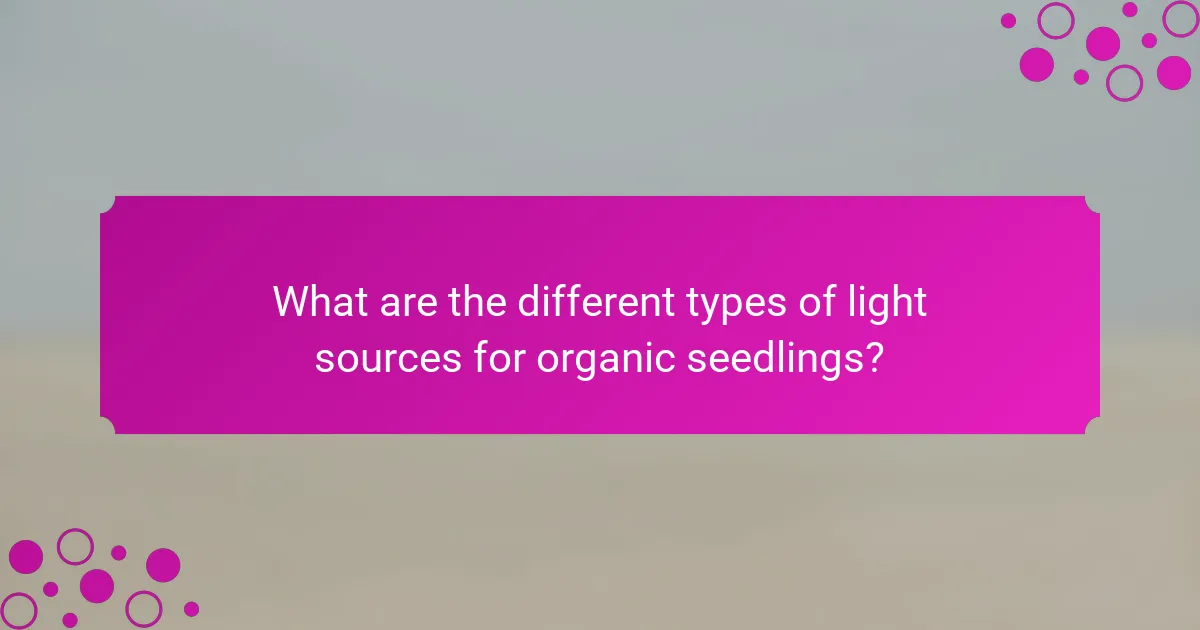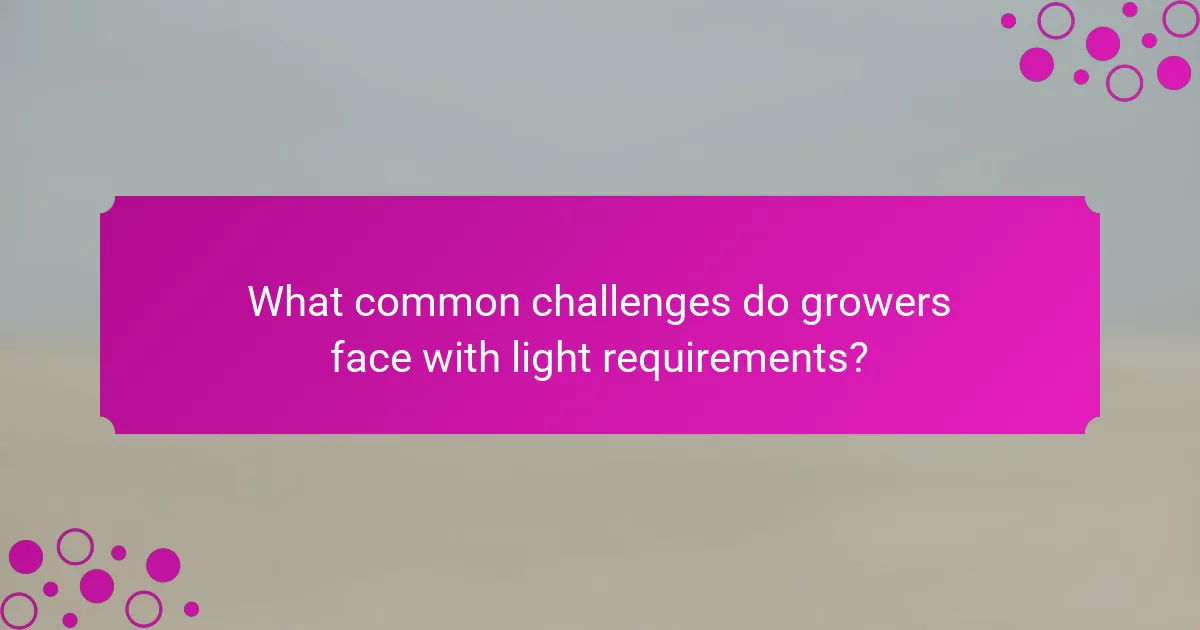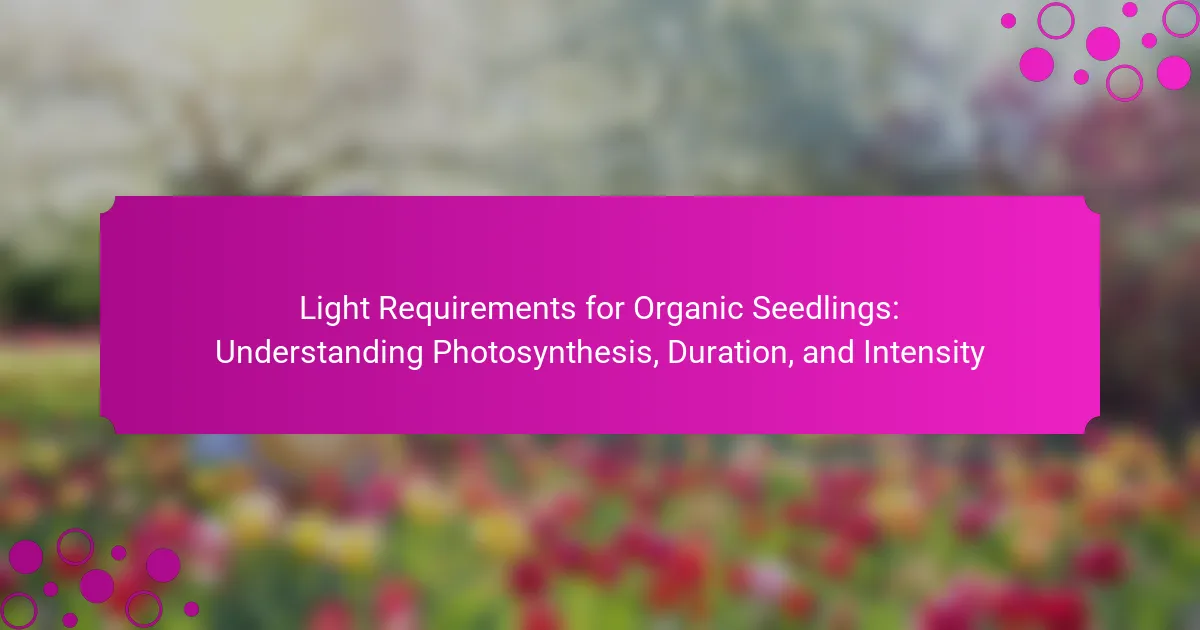Organic seedlings require specific light conditions for optimal growth, including 12 to 16 hours of light per day to facilitate photosynthesis. Adequate light intensity, measured between 200 to 400 µmol/m²/s, is essential to prevent issues such as leggy growth or leaf burn. Various light sources, including natural sunlight, fluorescent lights, LED lights, and incandescent bulbs, each have unique advantages and disadvantages affecting seedling health. Growers must navigate challenges related to light duration, intensity, and quality, especially in regions with varying daylight hours. Understanding these factors is crucial for promoting healthy organic seedling development and achieving successful harvests.

What are the light requirements for organic seedlings?
Organic seedlings require 12 to 16 hours of light per day for optimal growth. This duration supports effective photosynthesis, which is essential for their development. Seedlings thrive under bright, indirect light or full-spectrum grow lights. The light intensity should be around 200 to 400 µmol/m²/s for best results. Insufficient light can lead to leggy growth and poor health. Conversely, excessive light can cause leaf burn. Therefore, balancing light duration and intensity is crucial for healthy organic seedlings.
How does light affect the growth of organic seedlings?
Light is crucial for the growth of organic seedlings. It drives photosynthesis, the process by which plants convert light energy into chemical energy. This process produces glucose, which is essential for growth and development. Adequate light also influences seedling morphology, promoting healthy stem and leaf development.
Research indicates that light intensity and duration affect photosynthetic rates. For example, seedlings typically require 12 to 16 hours of light daily for optimal growth. Insufficient light can lead to elongated stems and weak plants, a condition known as etiolation.
Conversely, excessive light can cause leaf burn and stress. Therefore, balancing light exposure is key for healthy organic seedlings. Studies show that seedlings exposed to optimal light conditions exhibit faster growth and stronger resilience to environmental stressors.
What role does light play in photosynthesis for seedlings?
Light is essential for photosynthesis in seedlings. It provides the energy needed for the conversion of carbon dioxide and water into glucose and oxygen. Seedlings utilize chlorophyll to capture light energy. This energy drives the photosynthetic process, specifically in the chloroplasts. The intensity and duration of light affect the rate of photosynthesis. Studies show that adequate light increases biomass and growth rates in seedlings. Insufficient light can lead to stunted growth and poor health. Therefore, light is a critical factor for the successful development of seedlings through photosynthesis.
How do different light spectra influence seedling development?
Different light spectra significantly influence seedling development. Blue light promotes vegetative growth and leaf expansion. Red light enhances flowering and fruiting processes. Far-red light can affect germination and shade avoidance. Seedlings exposed to a balanced spectrum show improved overall health. Research indicates that specific wavelengths can optimize photosynthesis. For instance, a study by Morrow (2008) found that blue and red light combined increases biomass in seedlings. This demonstrates that light quality is crucial for effective seedling growth.
What are the key attributes of light for organic seedlings?
The key attributes of light for organic seedlings include intensity, duration, and spectrum. Intensity refers to the brightness of light, which directly influences photosynthesis rates. Organic seedlings typically require moderate to high light intensity for optimal growth. Duration, or photoperiod, is the length of time seedlings are exposed to light each day. Most organic seedlings benefit from 12 to 16 hours of light daily. Spectrum describes the specific wavelengths of light that plants use for photosynthesis. Blue light promotes vegetative growth, while red light supports flowering and fruiting. These attributes are essential for healthy seedling development and maximizing growth potential.
What is the importance of light intensity for seedlings?
Light intensity is crucial for seedlings as it directly affects photosynthesis rates. Adequate light intensity ensures optimal growth and development. Seedlings require sufficient light to produce energy through photosynthesis. Insufficient light can lead to weak, leggy plants with poor health. Research indicates that seedlings need specific light levels for proper chlorophyll production. For instance, studies show that light intensity impacts growth rates in various plant species. High light intensity generally promotes faster growth and stronger seedlings. Conversely, low light intensity can stunt growth and reduce yield potential. Thus, maintaining appropriate light levels is essential for healthy seedling development.
How does light duration impact seedling health?
Light duration significantly impacts seedling health. Adequate light duration promotes photosynthesis, which is essential for growth. Seedlings exposed to longer light periods typically show increased biomass and stronger root development. In contrast, insufficient light duration can lead to etiolation, where seedlings become leggy and weak. Research indicates that many plant species thrive with 12 to 16 hours of light per day. This duration supports optimal growth phases and enhances nutrient uptake. Studies have shown that seedlings with proper light duration exhibit better resistance to diseases. Therefore, light duration is a critical factor in ensuring healthy seedlings.
Why is understanding photosynthesis crucial for organic seedlings?
Understanding photosynthesis is crucial for organic seedlings because it directly affects their growth and development. Photosynthesis is the process by which plants convert light energy into chemical energy. This process enables seedlings to produce the sugars necessary for growth. Adequate light intensity and duration are vital for optimal photosynthesis. Insufficient light can lead to weak seedlings that struggle to thrive. Conversely, too much light can cause stress and damage. Research shows that seedlings require specific light wavelengths for effective photosynthesis. For instance, blue light promotes vegetative growth, while red light supports flowering. Therefore, understanding photosynthesis helps in providing the right light conditions for healthy organic seedlings.
What are the stages of photosynthesis in seedlings?
Photosynthesis in seedlings occurs in two main stages: light-dependent reactions and light-independent reactions. The light-dependent reactions take place in the thylakoid membranes of chloroplasts. These reactions require sunlight to convert light energy into chemical energy. During this stage, water molecules are split, releasing oxygen as a byproduct. The light-independent reactions, also known as the Calvin cycle, occur in the stroma of chloroplasts. This stage uses the chemical energy produced in the light-dependent reactions to convert carbon dioxide into glucose. Both stages are essential for the growth and energy supply of seedlings.
How do environmental factors influence photosynthesis rates?
Environmental factors significantly influence photosynthesis rates. Key factors include light intensity, temperature, and carbon dioxide concentration. Higher light intensity typically increases photosynthesis, up to a certain saturation point. Optimal temperatures enhance enzyme activity involved in photosynthesis. Elevated carbon dioxide levels can boost the rate of photosynthesis as well. Research indicates that photosynthesis can increase by 30% with sufficient light and carbon dioxide. Conversely, extreme temperatures or light deprivation can hinder the process. Studies show that plants exposed to varying environmental conditions exhibit different photosynthesis efficiencies.
How can growers optimize light conditions for organic seedlings?
Growers can optimize light conditions for organic seedlings by ensuring adequate light intensity and duration. Seedlings require 12 to 16 hours of light daily for optimal growth. Using full-spectrum LED lights can provide the necessary wavelengths for photosynthesis. Positioning lights 12 to 24 inches above seedlings prevents stretching while ensuring sufficient light. Regularly adjusting light height as seedlings grow maintains effective light exposure. Monitoring light quality is essential; seedlings thrive under cool white light. Additionally, rotating trays can ensure even light distribution. Implementing these practices can significantly enhance seedling health and growth rates.
What techniques can be used to measure light intensity for seedlings?
Light intensity for seedlings can be measured using several techniques. One common method is the use of a light meter. Light meters provide direct readings of light intensity in units such as lux or foot-candles. They are portable and easy to use, making them ideal for measuring light in different locations.
Another technique involves using a smartphone app designed for light measurement. These apps utilize the phone’s camera sensor to estimate light intensity. While not as precise as dedicated light meters, they can still provide useful approximations.
Additionally, quantum sensors can be employed to measure photosynthetically active radiation (PAR). These sensors specifically measure the light wavelengths that plants use for photosynthesis. They are particularly valuable in research settings.
Finally, a simple DIY method involves using a white paper or reflective surface. By observing the shadows cast by seedlings, one can qualitatively assess light intensity. However, this method is less precise than the others mentioned.
These techniques provide various ways to measure light intensity effectively for seedlings, ensuring optimal growth conditions.
How can artificial lighting be effectively used for seedling growth?
Artificial lighting can be effectively used for seedling growth by providing the appropriate spectrum, intensity, and duration of light. Full-spectrum lights, including LED and fluorescent options, mimic natural sunlight and support photosynthesis. Seedlings typically require 12 to 16 hours of light per day for optimal growth. The light intensity should be strong enough to prevent leggy growth but not so intense that it causes leaf burn. Positioning lights 6 to 12 inches above seedlings ensures adequate coverage. Regularly adjusting the height of the lights as seedlings grow maintains effective light exposure. Studies show that seedlings under artificial lighting exhibit faster growth rates and healthier development compared to those without sufficient light.

What are the different types of light sources for organic seedlings?
The different types of light sources for organic seedlings include natural sunlight, fluorescent lights, LED lights, and incandescent bulbs. Natural sunlight is the most effective light source, providing a full spectrum of light. Fluorescent lights are energy-efficient and suitable for indoor growing. LED lights offer adjustable spectrums and low heat output, making them ideal for seedlings. Incandescent bulbs are less efficient and produce more heat, which can be detrimental to seedlings. Each light source has its own benefits and drawbacks, impacting seedling growth and health.
What are the advantages of natural sunlight for seedlings?
Natural sunlight provides essential energy for seedlings to perform photosynthesis. This process allows seedlings to convert light energy into chemical energy, promoting growth. Sunlight contains a full spectrum of light, which is crucial for the development of chlorophyll. Chlorophyll is the pigment that enables plants to absorb light effectively. Additionally, natural sunlight helps regulate plant hormones, influencing growth patterns. Exposure to sunlight strengthens seedlings, making them more resilient to environmental stress. Studies show that seedlings grown in natural sunlight exhibit faster growth rates compared to those grown under artificial light. Overall, natural sunlight is vital for healthy seedling development.
How does sunlight exposure vary with seasons and locations?
Sunlight exposure varies significantly with seasons and locations. During summer, regions near the equator experience longer daylight hours and more intense sunlight. Conversely, winter brings shorter days and lower sunlight intensity in these areas. In temperate zones, sunlight exposure changes more drastically with seasons. Spring and summer provide longer days and higher sun angles, enhancing exposure. During fall and winter, days shorten, and the sun’s angle decreases, reducing exposure. Locations at higher latitudes experience greater seasonal variation. For example, places like Alaska have extreme differences, with prolonged daylight in summer and limited sunlight in winter. This variation affects plant growth and photosynthesis in organic seedlings, as they require adequate sunlight for optimal development.
What are the limitations of relying solely on sunlight?
Relying solely on sunlight has several limitations. Sunlight availability fluctuates throughout the day and varies by season. This inconsistency can hinder plant growth, especially in regions with shorter daylight hours. Additionally, not all wavelengths of sunlight are equally effective for photosynthesis. Plants require specific light spectra, which may not be adequately provided by natural sunlight alone. Furthermore, excessive sunlight can lead to overheating and water loss in seedlings. This can stress plants and reduce their overall health. Lastly, weather conditions such as clouds, rain, or pollution can further diminish sunlight intensity. These factors collectively limit the effectiveness of relying solely on sunlight for optimal plant growth.
What artificial light sources are best for organic seedlings?
LED grow lights are the best artificial light sources for organic seedlings. They provide a full spectrum of light, essential for photosynthesis. LED lights are energy-efficient and produce less heat. This reduces the risk of overheating seedlings. Fluorescent lights are also effective, particularly T5 tubes. They are less expensive and provide adequate light for seedling growth. High-Intensity Discharge (HID) lights can be used but generate more heat. This requires careful temperature management. Studies show that seedlings grow faster under LED lights compared to traditional lighting options.
How do LED lights compare to fluorescent lights for seedlings?
LED lights provide more efficient energy use and targeted light spectrum for seedlings compared to fluorescent lights. LED lights consume less electricity, reducing energy costs. They also produce less heat, minimizing the risk of overheating seedlings. Fluorescent lights can be bulkier and generate more heat, requiring careful placement. The specific light spectrum from LEDs can enhance photosynthesis, promoting faster growth. Research indicates that plants under LED lights show improved growth rates and healthier foliage. In contrast, fluorescent lights typically emit a broader spectrum, which may not be as beneficial for all seedling types. Overall, LED lights are often preferred for seedling growth due to their efficiency and effectiveness.
What factors should be considered when choosing an artificial light source?
When choosing an artificial light source, factors such as light spectrum, intensity, duration, energy efficiency, and heat output should be considered. The light spectrum is crucial because plants require specific wavelengths for photosynthesis. Intensity affects how well plants can grow; too little light can hinder growth. Duration refers to the length of time plants are exposed to light each day, which impacts their development. Energy efficiency is important for reducing electricity costs and environmental impact. Heat output must be managed to prevent overheating, which can damage plants. Each of these factors plays a significant role in supporting healthy plant growth.

What common challenges do growers face with light requirements?
Growers face several common challenges with light requirements. Insufficient light can lead to poor plant growth and reduced yields. Many growers struggle to provide adequate light duration, especially in regions with shorter daylight hours. Intensity of light is also a concern; too much can cause leaf burn, while too little can hinder photosynthesis. Additionally, varying light quality affects plant development, making it essential for growers to understand the specific needs of their crops. Seasonal changes can complicate light management, requiring adjustments in artificial lighting. Understanding these challenges is crucial for optimizing growth and achieving successful harvests.
What issues arise from insufficient light for organic seedlings?
Insufficient light for organic seedlings leads to stunted growth and weak plants. Seedlings require adequate light for photosynthesis, which is essential for energy production. Without sufficient light, seedlings may exhibit elongated stems and pale leaves, a condition known as etiolation. This weakens their structure and makes them more susceptible to diseases. Additionally, insufficient light can result in poor root development. Healthy root systems are crucial for nutrient and water uptake. Research indicates that seedlings need around 12 to 16 hours of light daily for optimal growth. Lack of light can also delay flowering and fruiting in later stages. Overall, insufficient light negatively impacts the health and productivity of organic seedlings.
How can growers identify signs of light deficiency in seedlings?
Growers can identify signs of light deficiency in seedlings by observing their growth patterns and physical characteristics. Seedlings may exhibit elongated stems, also known as etiolation. This occurs as they stretch toward the light source. Leaf color can also indicate light deficiency; leaves may become pale or yellow. Additionally, seedlings may develop smaller leaves than normal. A lack of robust growth and overall weak appearance are further signs. Inadequate light can lead to increased susceptibility to disease and pests. Monitoring these signs helps growers adjust light conditions effectively.
What are the potential consequences of inadequate lighting?
Inadequate lighting can severely impact the growth and development of organic seedlings. Insufficient light leads to poor photosynthesis, which is essential for plant energy production. This results in stunted growth and weak plants. Additionally, inadequate lighting can cause elongated stems, known as etiolation, as seedlings stretch towards light sources. Furthermore, low light levels may increase susceptibility to diseases and pests. Research indicates that plants require specific light intensities for optimal growth, and failure to meet these requirements can hinder overall health. In summary, inadequate lighting adversely affects seedling vigor, growth rate, and resilience.
What are the effects of excessive light on organic seedlings?
Excessive light can harm organic seedlings. It leads to photoinhibition, which reduces photosynthesis efficiency. Organic seedlings may exhibit leaf scorch or bleaching under intense light. High light intensity can cause water loss through increased transpiration. This stress can stunt growth and lead to wilting. In severe cases, excessive light can result in cell damage and death. Research indicates that optimal light levels are crucial for healthy seedling development. Maintaining appropriate light conditions is essential for maximizing growth and vitality.
How can growers recognize symptoms of light stress in seedlings?
Growers can recognize symptoms of light stress in seedlings by observing changes in leaf color and growth patterns. Seedlings may exhibit pale or yellowing leaves, indicating insufficient light. Additionally, seedlings may become leggy with elongated stems as they stretch toward the light source. Leaf curling or wilting can also occur due to light stress. These symptoms are often accompanied by slower overall growth. Monitoring these signs helps growers adjust light conditions effectively. Proper lighting is crucial for healthy seedling development.
What strategies can mitigate the impact of too much light?
To mitigate the impact of too much light on organic seedlings, several strategies can be employed. First, adjusting the light intensity is crucial. This can be done by moving light sources further away or using dimmable lights. Second, implementing light filters can reduce brightness while still allowing necessary wavelengths for photosynthesis. Third, providing shade during peak light hours can protect seedlings from excessive exposure. Fourth, using reflective materials can help distribute light evenly without overwhelming the plants. Lastly, monitoring light duration is essential; limiting exposure to optimal hours can prevent stress. These strategies are supported by research indicating that excessive light can lead to photoinhibition, negatively impacting seedling growth and health.
What practical tips can help optimize light for organic seedlings?
To optimize light for organic seedlings, provide 12 to 16 hours of light daily. This duration supports robust photosynthesis, essential for growth. Use full-spectrum grow lights to mimic natural sunlight. These lights deliver the necessary wavelengths for seedling development. Position lights 2 to 4 inches above seedlings to prevent stretching. This distance ensures adequate light intensity without causing heat stress. Rotate seedlings regularly for even light exposure. This practice prevents uneven growth patterns. Monitor light intensity with a light meter. Adjust as needed to maintain optimal levels. Finally, ensure seedlings receive a dark period for rest. This cycle promotes healthy growth and development.
How can growers create a balanced light environment for seedlings?
Growers can create a balanced light environment for seedlings by ensuring adequate light intensity and duration. The ideal light intensity for seedlings typically ranges from 200 to 400 µmol/m²/s. This range supports optimal photosynthesis without causing light stress. Additionally, seedlings require about 14 to 16 hours of light daily for healthy growth.
Using full-spectrum LED grow lights can effectively provide the necessary light spectrum. These lights simulate natural sunlight, promoting balanced growth. Adjusting the distance between the light source and seedlings helps control light intensity. A distance of 12 to 24 inches is often recommended, depending on the light’s strength.
Monitoring the seedlings for signs of light deficiency or excess is crucial. Yellowing leaves may indicate insufficient light, while burnt leaf tips suggest too much light. Regular adjustments based on these observations will help maintain a balanced light environment.
What best practices should be followed for light management in seedling care?
Seedlings require specific light management practices for optimal growth. Provide 12 to 16 hours of light daily to mimic natural conditions. Use grow lights to supplement natural sunlight, especially in low-light seasons. Position lights 2 to 4 inches above seedlings to prevent stretching. Monitor light intensity using a light meter for accuracy. Adjust light duration based on seedling growth stages; younger seedlings need less intense light. Rotate seedlings regularly to ensure even light exposure. Maintain a consistent temperature around seedlings to support photosynthesis. These practices enhance photosynthesis, promoting healthy seedling development.
Light requirements for organic seedlings are critical for their growth and development, primarily influenced by photosynthesis. Seedlings typically need 12 to 16 hours of light daily, with an intensity of 200 to 400 µmol/m²/s for optimal health. The article explores how light duration, intensity, and spectrum affect seedling morphology and overall vitality, highlighting the importance of balancing these factors to prevent issues such as etiolation or leaf burn. Additionally, it discusses the role of different light sources, including natural sunlight and artificial options like LED and fluorescent lights, in supporting robust seedling growth. Understanding these light requirements is essential for growers aiming to optimize the health and productivity of organic seedlings.
